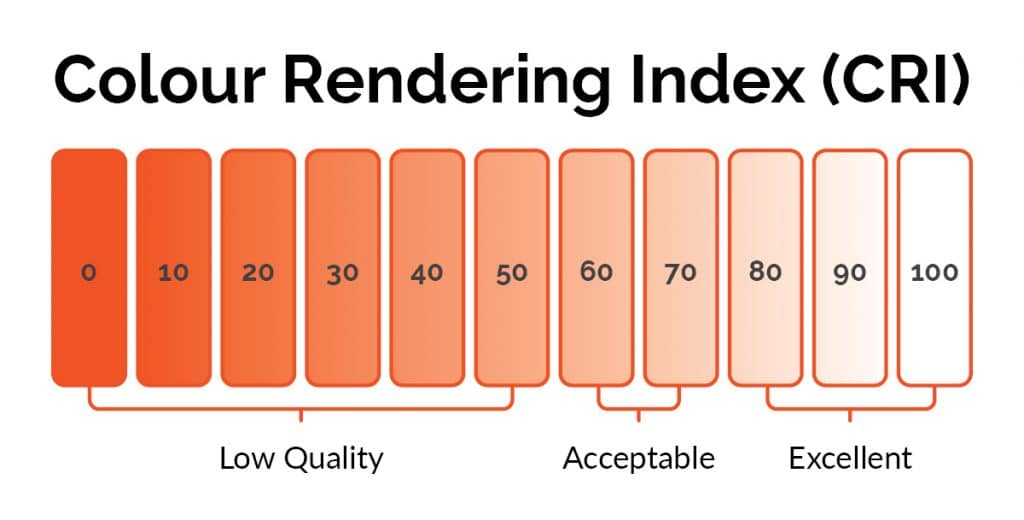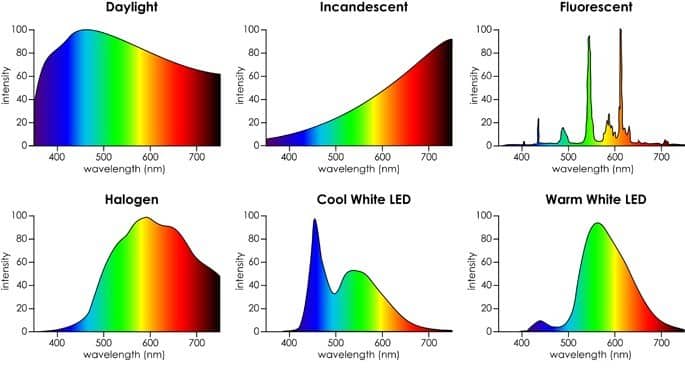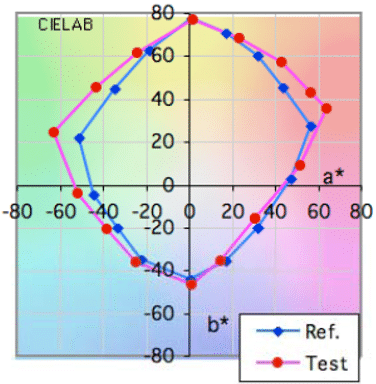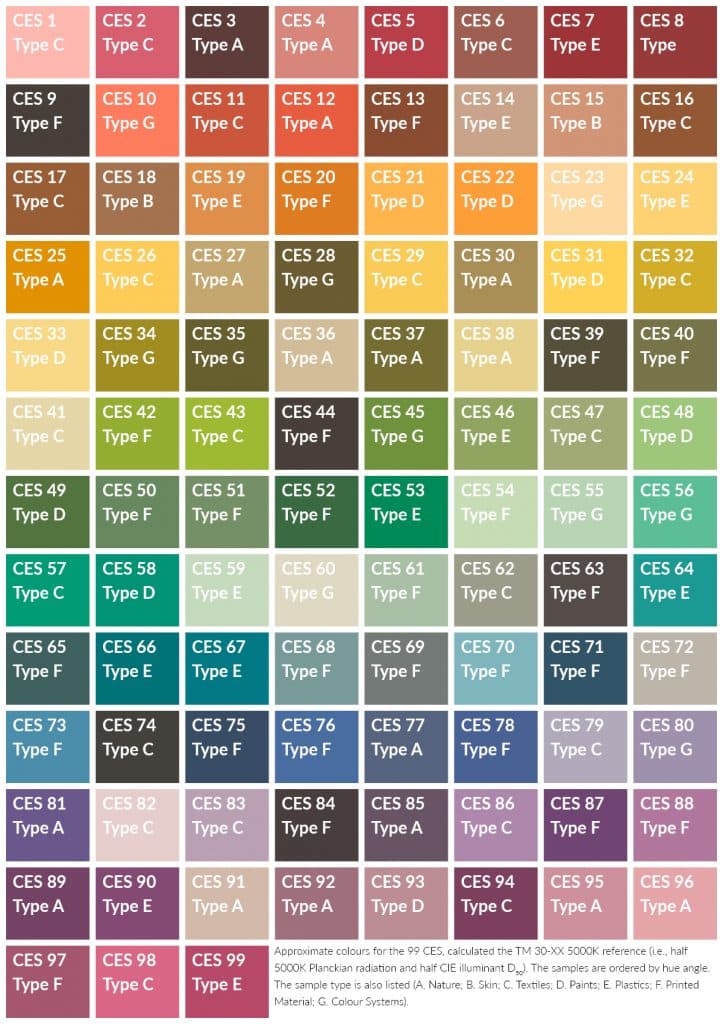Latest News
CRI, TM30 and CQS?

Lighting plays a key role in the visual environment of any space. The quality of lighting is measured by various metrics, such as the Colour Rendering Index (CRI), Colour Quality Scale (CQS) and TM-30. These three metrics provide insight into how accurately colours appear under different light sources, but there are distinct differences between them which need to be understood to ensure the best lighting for any given application. In this article, we will explain the differences between CRI, CQS and TM-30, and discuss how they can be used to measure the quality of a light source.
CRI (Colour Rendering Index)
The Colour Rendering Index (CRI) is the most widely used metric for evaluating light sources. It measures the ability of a light source to accurately render colours compared to a reference light source, with higher scores indicating better colour rendering. CRI is expressed as a number between 0 and 100, with higher numbers indicating better colour fidelity. However, it does not provide an accurate measure of how realistic or natural colours appear under different light sources, making it less suitable for applications where colour accuracy is paramount.


The history and criticism
The Colour Rendering Index (CRI) is a scale from 0-100 which measures the quality of light. It was originally developed in 1976 by the International Commission on Illumination (known as CIE) with the goal of providing an objective measure for the effectiveness of simulated daylight or artificial lighting. High CRI has become increasingly important in recent years, particularly due to the rise of LED lighting products, since low CRI can have noticeable detrimental effects such as inaccurate representation of colour and accentuating unflattering skin tones. However, while its popularity is undeniable, it has also been subject to criticism due to certain issues that its calculation presents.
The Colour Rendering Index (CRI) is a numerical scale used to quantify how accurately colours are rendered under a particular light source when compared to natural sunlight or incandescent light. It measures colour fidelity by comparing 8 standard colours samples under both the test source and a reference illuminant, such as Daylight illuminant D65 or incandescent A. A score between 0-100 is then calculated based on how closely these two sources match; higher scores indicate greater accuracy in colour rendering compared to natural sunlight or incandescent illumination when viewed from specific angles. This score helps consumers understand an artificial light’s capability in accurately rendering colour information when illuminating physical objects or images.
Despite this, there have been criticisms about CRI’s efficacy and relevance – specifically, whether the method accurately and comprehensively quantifies colour rendition in modern lighting technologies such as LEDs versus traditional light sources such as tungsten filaments or sodium lamps (used primarily for street lighting). Certain issues raised include:
1) Limitations in testing range– CRI only tests 8 shades which may not be sufficient enough to compare complexly coloured environments/ wallpapers/ fabrics etc. which involves multiple hues and saturation levels
2) Limited usefulness – Experiments show that Ra values remain relatively constant even if many other lighter factors like brightness change – making it difficult to judge true colour rendition
3) New technologies & techniques – More advanced LED chips use multiwavelength radiation techniques but are still tested using single wavelength methods – leading certain researchers to speak out against using CRI at all
Despite these reservations, much research continues into alternative methods for assessing colour rendering including analysing colour coefficients instead of breaking down chromaticity coordinates with CIELAB data formats and vector diagrams commonly used for measuring angles between primaries etc., however none have yet reached reliability or standardisation comparable with the already established CRI system just yet . To conclude, one should always treat measurements provided by manufacturers results accordingly, especially bearing in mind that each application requires a different level of evaluation and judgement despite past and present criticisms surrounding coloured rendering index.

Colour Quality Scale (CQS)
The history and criticism
The Colour Quality Scale (CQS) is used to measure the inherent colour quality and consistency of a material. This scale was developed by the International Commission on Illumination (CIE) in 1995 and has since been widely implemented as a universal tool for colour evaluation purposes. It establishes a set of standards used to compare colours and assess their compliance with established quality requirements.
History of CQS: The development of the Colour Quality Scale dates back to the mid 1990s when the CIE published its initial version (CIE 116:1995). This first version provided methods that could be used to judge acceptable colour differences between two objects under different lighting conditions. In 2008, an update was released which further refined these standards: CIE S022/E2010. This version updated tolerances for material colours as well as other factors such as surface gloss, texture, and contrast ratio.
Certification Process for CQS: According to the IEC 60086-5 standard, materials need to meet certain criteria in order pass through a testing process for certification under CQS. Firstly, all samples must be delivered pre-tested according to ISO 11477 or NEMA 250 standards, so that they can be further compared against one another accurately. Samples are then tested on a spectrophotometer using a sample strip test showing the amount of reflectance or transmittance exhibited by each colour shade being observed under various lighting conditions. The readings are then compared with consensus values compiled from multiple observers’ evaluations before final results regarding colour stability and quality can be achieved and issued under accordance with current testing protocol regulations (IEC 60086).
Criticism: Despite being widespread in use globally over many industries, many have voiced their criticisms over this scale due its mandatory use standards put out by IEC 60086-5:2016 limits it restricts professional manufacturing companies from providing customers with specific instructions on how best to implement Colour Quality Scales into internal company processes via guidelines specified by enterprise regulations or customer demand in certain cases outcomes may differ slightly from original predictions based upon inconsistencies within actual testing environments or changes in raw material formulation during production procedures .
TM-30
TM-30 is the latest metric for evaluating light sources. It was developed to provide an even more accurate measure of how realistic or natural colours appear under different light sources than either CRI or CQS. Unlike CRI and CQS, which are expressed as a single number between 0 and 100, TM-30 provides three separate metrics: Rf (Colour Fidelity Index), Rg (Gam ma Index) and Rd (Red Index). These three metrics provide a detailed breakdown of how accurately colours appear under different light sources, and can be used to determine the best light source for specific applications.


The Beginning of TM-30
TM-30 was officially launched in January 2016 after years of research conducted by experts at IES. The aim was to provide a more comprehensive measure than traditional Colour Rendering Index (CRI) that takes into account more aspects of colour rendition, rather than just hues. The system encompasses several metrics including Colour Fidelity Index Rf (CFI) which aims to determine how faithfully colours are depicted under various lighting conditions, and Gamut Area Index GAI which reveals the overall size and shape of colour gamut when illuminated by different light sources.
Criticisms Of TM-30
Though widely accepted as an improvement on CRI measurements, some experts have voiced concerns about TM-30’s complexity and lack of data about its practical benefits compared with CRI rating systems. Others have suggested that it’s overly inefficient as far as task illumination is concerned or doesn’t take into account important factors like flicker or glare. It should also be noted that while CRI ratings are internationally recognised, much less widespread acceptance exists for TM-30 outside North America.
Advantages and disadvantages
The main advantage of CRI is that it is the most widely used and accepted metric for measuring colour fidelity. It is also relatively simple to understand, making it a good choice for general lighting applications. However, its accuracy is limited when it comes to accurately rendering colours under different light sources.
The main advantage of CQS over CRI is that it provides a more accurate measure of how realistic or natural colours appear under different light sources. This makes it a better choice for applications where colour accuracy is paramount. The main disadvantage of CQS compared to CRI is that it requires more complex calculations and can be more difficult to understand.
TM-30 provides the most detailed breakdown of colour accuracy available, making it an ideal choice for applications where colour accuracy is critical. The main disadvantage of TM-30 compared to CRI and CQS is that it requires the most complex calculations and can be the most difficult to understand.
Overall, each of the three metrics has its own unique advantages and disadvantages. CRI is the most widely accepted metric and provides a good overall measure of colour fidelity. CQS offers an improved level of accuracy, while TM-30 provides the most detailed breakdown available. Choosing the right metric for any given application depends on the specific requirements and desired outcome. For example, if an application requires more accurate colour rendering, then using TM-30 would be recommended; however, if colour accuracy is not as critical, then CRI or CQS may be sufficient. Ultimately, it is essential to understand the differences between all three metrics in order to choose the best light source for any given application.
In conclusion, CRI, CQS and TM-30 are all metrics used to measure the quality of lighting. However, each one provides a different level of accuracy when it comes to measuring how accurately colours appear under different light sources. CRI is the most widely used metric and provides a good overall measure of colour fidelity. CQS offers an improved level of accuracy, while TM-30 provides the most detailed breakdown of colour accuracy available. By understanding the differences between these three metrics, it is possible to choose the best light source for any given application.
Want to find out more or need further information? Get in touch with our team or contact 1300 601 931 for further information.
We're a Casambi certified commissioning partner